- Home
- About
- Map
- Trips
- Bringing Boat West
- Migration West
- Solo Motorcycle Ride
- Final Family XC Trip
- Colorado Rockies
- Graduates' XC Trip
- Yosemite & Nevada
- Colorado & Utah
- Best of Utah
- Southern Loop
- Pacific Northwest
- Northern Loop
- Los Angeles to NYC
- East Coast Trips
- Martha's Vineyard
- 1 Week in Quebec
- Southeast Coast
- NH Backpacking
- Martha's Vineyard
- Canadian Maritimes
- Ocracoke Island
- Edisto Island
- First Landing '02
- Hunting Island '02
- Stowe in Winter
- Hunting Island '01
- Lake Placid
- Chesapeake
- Provincetown
- Hunting Island '00
- Acadia in Winter
- Boston Suburbs
- Niagara Falls
- First Landing '99
- Cape Hatteras
- West Coast Trips
- Burning Man
- Utah Off-Roading
- Maui
- Mojave 4WD Course
- Colorado River Rafting
- Bishop & Death Valley
- Kauai
- Yosemite Fall
- Utah Off-Road
- Lost Coast
- Yosemite Valley
- Arizona and New Mexico
- Pescadero & Capitola
- Bishop & Death Valley
- San Diego, Anza Borrego, Joshua Tree
- Carmel
- Death Valley in Fall
- Yosemite in the Fall
- Pacific Northwest
- Utah Off-Roading
- Southern CA Deserts
- Yosemite & Covid
- Lake Powell Covid
- Eastern Sierra & Covid
- Bishop & Death Valley
- Central & SE Oregon
- Mojave Road
- Eastern Sierra
- Trinity Alps
- Tuolumne Meadows
- Lake Powell Boating
- Eastern Sierra
- Yosemite Winter
- Hawaii
- 4WD Eastern Sierra
- 4WD Death Valley +
- Southern CA Deserts
- Christmas in Tahoe
- Yosemite & Pinnacles
- Totality
- Yosemite & Sierra
- Yosemite Christmas
- Yosemite, San Diego
- Yosemite & North CA
- Seattle to Sierra
- Southwest Deserts
- Yosemite & Sierra
- Pacific Northwest
- Yosemite & South CA
- Pacific Northwest
- Northern California
- Southern Alaska
- Vancouver Island
- International Trips
- Index
- Tips
- Books
- Photos/Videos
- Search
- Contact
Campland on the Bay and San Diego Side Trips, CA
Friday, December 6, 2013 - 12:00pm by Lolo
178 miles and 3.5 hours from our last stop - 2 night stay
Travelogue
 Mission Bay Birds of ParadisePoor Herb. He had so much been looking forward to the San Diego portion of our trip -- so had I for that matter, but he is much more of a sun worshipper and beachgoer than me. But alas, the weather was just not going to cooperate. Not only had a cold front that was making national news moved in, but it was forecast to rain during our stay as well. We were determined to make the best of it and chalk it up to an exploratory for future visits.
Mission Bay Birds of ParadisePoor Herb. He had so much been looking forward to the San Diego portion of our trip -- so had I for that matter, but he is much more of a sun worshipper and beachgoer than me. But alas, the weather was just not going to cooperate. Not only had a cold front that was making national news moved in, but it was forecast to rain during our stay as well. We were determined to make the best of it and chalk it up to an exploratory for future visits.
We did find a great campground called Campland on the Bay, located right on beautiful Mission Bay. The campground was huge -- over 550 campsites, two pools and Jacuzzis, and a fitness room with top-notch exercise equipment. Plus, they have their own sandy beach on Mission Bay and a marina that rents powerboats, jet skis, and kayaks.
 Bicycling Along Mission BayAs soon as we arrived, we hopped on our bikes to take advantage of the fact that it wasn’t raining yet. We set off on the 12-mile bike path that encircles beautiful Mission Bay, hoping to complete all of it before it got dark. The ride was lovely and passed through several public parks and wildlife reserves and eventually came to the giant parking lot for Seaworld. This is where the route got a bit confusing and we screwed up. Rather than continuing straight to get to Mission Beach, we made a right turn onto Ingraham Street and went over the causeway that bisects the bay. We realized our mistake too late to turn back, which kind of bummed me out because Mission Beach was what I most wanted to see. Oh well. Nice ride anyway and maybe we could go to Mission Beach by car another time.
Bicycling Along Mission BayAs soon as we arrived, we hopped on our bikes to take advantage of the fact that it wasn’t raining yet. We set off on the 12-mile bike path that encircles beautiful Mission Bay, hoping to complete all of it before it got dark. The ride was lovely and passed through several public parks and wildlife reserves and eventually came to the giant parking lot for Seaworld. This is where the route got a bit confusing and we screwed up. Rather than continuing straight to get to Mission Beach, we made a right turn onto Ingraham Street and went over the causeway that bisects the bay. We realized our mistake too late to turn back, which kind of bummed me out because Mission Beach was what I most wanted to see. Oh well. Nice ride anyway and maybe we could go to Mission Beach by car another time.
The next morning we woke up to cloudy skies, but still not raining yet, so we drove over to Torrey Pines State Beach to take a walk. We parked in the lot just south of the Glider Port on the southernmost end of the park. The weather didn’t seem to stop a few brave souls from leaping off the bluff and paragliding along the bluff overlooking Black’s Beach.
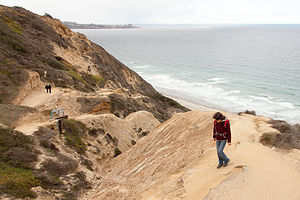 Hike Down to Torrey Pines State BeachWhile the beach at the northern end of Torrey Pines is easily accessible by car, on the southern end you have to work for. The very steep and somewhat precarious south trail switchbacks down from the Glider Port parking lot to Black’s Beach, with great views along the way. It’s only 1,000 feet long, but its 320 foot descent in that short distance, makes it feel much longer. However, the trail is well maintained and there are steps and handrails in the steeper sections.
Hike Down to Torrey Pines State BeachWhile the beach at the northern end of Torrey Pines is easily accessible by car, on the southern end you have to work for. The very steep and somewhat precarious south trail switchbacks down from the Glider Port parking lot to Black’s Beach, with great views along the way. It’s only 1,000 feet long, but its 320 foot descent in that short distance, makes it feel much longer. However, the trail is well maintained and there are steps and handrails in the steeper sections.
Once at the bottom, we headed right, or north, up the beach where the paragliders were flying overhead. This is also the clothing optional section of the beach, but clothing was definitely a necessity and not an option today.
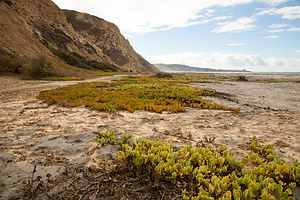 Torrey Pines State BeachWe walked down the beach about a ½ mile figuring we would retrace our steps and go back up the way we came down. That’s before we saw a man with a giant pack on his back head directly towards the cliffs and up a narrow path that we hadn’t even noticed. Perhaps, it would have been better if we hadn’t discovered this route up, because it was pretty rough for me, much more difficult than our way down. This must be the precarious north trail that I read about.
Torrey Pines State BeachWe walked down the beach about a ½ mile figuring we would retrace our steps and go back up the way we came down. That’s before we saw a man with a giant pack on his back head directly towards the cliffs and up a narrow path that we hadn’t even noticed. Perhaps, it would have been better if we hadn’t discovered this route up, because it was pretty rough for me, much more difficult than our way down. This must be the precarious north trail that I read about.
The gentleman, who was extremely friendly and nice, introduced himself as Ziggy and explained that he had run out of wind and had to land his paraglider on the beach – the preference is to continue soaring back and forth above the bluffs. We got to talking a bit more and found out that Ziggy had quite an impressive adventure resume, including activities such as mountaineering and ice climbing throughout Europe. He had only started paragliding a few years ago when he was 55. Part of me doesn’t like when Herb meets people like this, because then he feels even more driven to do things that might be beyond my fear level, but the other part of me likes to see that people our age are still so physically active and often just starting out on new adventurous hobbies.
 La Jolla OceanfrontOne criticism I do have about Herb is that he sometimes has what I consider a pessimistic perspective on where we are in the aging process, making me feel like a walker might be my next piece of recreational equipment. He, however, feels that we should be very aware of the fact that we are not going to be able to do the physically challenging things we like to do forever, so we should go at them with gusto while we can. I guess he is right, but I would just prefer taking this approach without thinking about why – I am perfectly willing to hide my head in the sand on this one.
La Jolla OceanfrontOne criticism I do have about Herb is that he sometimes has what I consider a pessimistic perspective on where we are in the aging process, making me feel like a walker might be my next piece of recreational equipment. He, however, feels that we should be very aware of the fact that we are not going to be able to do the physically challenging things we like to do forever, so we should go at them with gusto while we can. I guess he is right, but I would just prefer taking this approach without thinking about why – I am perfectly willing to hide my head in the sand on this one.
We parted with Ziggy at the Glider Port atop the bluff and headed into nearby La Jolla, San Diego’s most affluent neighborhood, to walk around and visit the Museum of Contemporary Art. As was expected, it was a lovely town with many fine restaurants, jewelry shops, and art galleries.
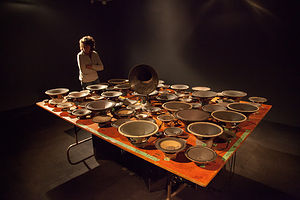 Multimedia Exhibit at Museum of Contemporary Art - La JollaOur favorite was the Peter Lik Photo Gallery. Herb had probably seen all the episodes of his TV show, “From the Edge with Peter Lik,” where this down to earth Australian adventure photographer goes anywhere and takes on any risk to get the ultimate shot. And, he usually does. That is why he now has a dozen or so galleries around the U.S., where his wide-angled, panoramic landscape photos sell for as much as $1,000,000.
Multimedia Exhibit at Museum of Contemporary Art - La JollaOur favorite was the Peter Lik Photo Gallery. Herb had probably seen all the episodes of his TV show, “From the Edge with Peter Lik,” where this down to earth Australian adventure photographer goes anywhere and takes on any risk to get the ultimate shot. And, he usually does. That is why he now has a dozen or so galleries around the U.S., where his wide-angled, panoramic landscape photos sell for as much as $1,000,000.
Needless to say, we were just window shopping, so I panicked when the sales assistant, who was very friendly and informative, and I liked him up until now, asked us, “What kind of art do you have hanging on your wall.” Herb pretended to not hear the question and slinked away, allowing me to take this one alone. I think I mumbled something incoherent and changed the subject. To get even I should have said, “Nothing, because my cheap husband won’t buy me any,” but I was above that. In hindsight, I should have said our own photos of our wonderful adventures together as a family, some of them even better than Peter Lik’s, but I couldn’t think that fast.
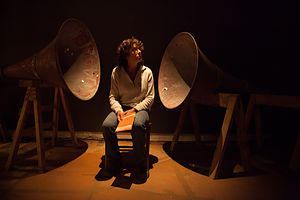 Lolo getting an Earful of Art at La Jolla Museum of Contemporary ArtOur next stop was the Museum of Contemporary Art, which is part of the San Diego Art Museum. It’s located atop a bluff above the waterfront in what was once the home of philanthropist Ellen Browning Scripps, the founding donor of such learning institutions as the Scripps Institution of Oceanography and Scripps Research Institute. The museum was quite small and at first I thought its exhibits would not keep us occupied for more than ½ hour. That was until we discovered the interactive, multimedia exhibits in the back of the museum.
Lolo getting an Earful of Art at La Jolla Museum of Contemporary ArtOur next stop was the Museum of Contemporary Art, which is part of the San Diego Art Museum. It’s located atop a bluff above the waterfront in what was once the home of philanthropist Ellen Browning Scripps, the founding donor of such learning institutions as the Scripps Institution of Oceanography and Scripps Research Institute. The museum was quite small and at first I thought its exhibits would not keep us occupied for more than ½ hour. That was until we discovered the interactive, multimedia exhibits in the back of the museum.
The first one we experienced was a box, probably about 4 ft x 4ft x 4 ft that that contained a miniature movie theater, complete with theater seats and a movie screen. When I looked into the box, I felt as if I were standing at the back of the theater looking over the other theatergoers at a movie clip being played over and over again in an endless loop. The audio was both of the movie as well as whisperings of the audience, so I kind of felt like I was eavesdropping on their conversations. It made me question what was reality and what was illusion, as I found myself being drawn into thinking I was part of the audience itself, and could, if I wanted, join in on the whisperings.
 Lolo with Hammering ManIn another exhibit, we wandered around the clutter of someone’s room that must have been a hoarder. As we approached different objects, some of them would start to move, or voices would start talking. There were some objects in the room that you were allowed and even encouraged to touch, but it was hard to tell which. I was stopped by a staff member when I reached for something I shouldn’t have, so I played it safe from there on and kept my hands to myself. At one point, I sat on a chair between two large old style speakers, the kind that looked like tubas, and voices immediately and quite loudly started coming out of them. I found myself literally in the middle of a conversation between a man and a woman.
Lolo with Hammering ManIn another exhibit, we wandered around the clutter of someone’s room that must have been a hoarder. As we approached different objects, some of them would start to move, or voices would start talking. There were some objects in the room that you were allowed and even encouraged to touch, but it was hard to tell which. I was stopped by a staff member when I reached for something I shouldn’t have, so I played it safe from there on and kept my hands to myself. At one point, I sat on a chair between two large old style speakers, the kind that looked like tubas, and voices immediately and quite loudly started coming out of them. I found myself literally in the middle of a conversation between a man and a woman.
It was really quite interesting experience, much less passive than the usual museum experience, and much better than my expectations when I first entered.
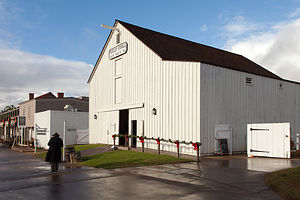 Seeley Stable MuseumThe next stop on our cook’s tour of San Diego was Cabrillo National Monument at the tip of the Point Luma Peninsula, a memorial to the site where the first European, Juan Rodriguez Cabrillo, stepped foot on the West Coast of the U.S. in 1542.
Seeley Stable MuseumThe next stop on our cook’s tour of San Diego was Cabrillo National Monument at the tip of the Point Luma Peninsula, a memorial to the site where the first European, Juan Rodriguez Cabrillo, stepped foot on the West Coast of the U.S. in 1542.
Unfortunately, by now the rain had begun in earnest and we got soaked running from our car to the Visitor Center. Too bad, because it was a very pretty spot and would have been fun to explore on a better day. We waited out the heavy rain in the Visitor Center and then walked out to the 14-foot statue of Cabrillo, located in a small circular plaza overlooking San Diego and the harbor.
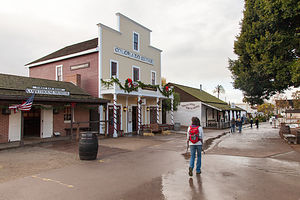 Old Town San Diego State Historic ParkIf we come back here again, which I am sure we will, the other things I would like to do are: visit the Old Point Loma Lighthouse, look for Pacific gray whales from the Whale Overlook, and hike the two-mile Bayside Trail from the lighthouse. The views along the way are supposed to be spectacular.
Old Town San Diego State Historic ParkIf we come back here again, which I am sure we will, the other things I would like to do are: visit the Old Point Loma Lighthouse, look for Pacific gray whales from the Whale Overlook, and hike the two-mile Bayside Trail from the lighthouse. The views along the way are supposed to be spectacular.
Continuing on a history theme, we drove over to the Old Town State Historic Park to see what life was like in 1872 San Diego during the period of Mexican influence. We have been to many of these living history types of villages, especially on the East Coast, where there is much more history – just kidding, but seriously the East Coast has about a 100 years at least on the West.
 Lolo on Mission Beach BoardwalkProbably the closest East Coast parallel to Old Town that I can think of is Sturbridge Village in central Massachusetts, mostly because, like Sturbridge, many of the buildings clustered around the Old Town Plaza were really gift shops and eating establishments housed in historic buildings – not that that is a bad thing, as that is what most people are looking for.
Lolo on Mission Beach BoardwalkProbably the closest East Coast parallel to Old Town that I can think of is Sturbridge Village in central Massachusetts, mostly because, like Sturbridge, many of the buildings clustered around the Old Town Plaza were really gift shops and eating establishments housed in historic buildings – not that that is a bad thing, as that is what most people are looking for.
Probably my favorite two buildings in Old Town were the Casa de Estudillo, the elaborate adobe home and central courtyard of a wealthy Mexican family in 1862, and the Seeley Stable, an old stagecoach stop that now houses an excellent wagon and carriage collection.
 Mission Beach ShopsOur final destination in San Diego was Mission Beach, which we had missed on our bike ride the previous evening because of a wrong turn. It was extremely windy and quite cool, so we were able to easily get parking, right next to the Giant Dipper, a classic wooden roller coaster built in 1925. Unfortunately, it wasn’t running today because of the weather conditions.
Mission Beach ShopsOur final destination in San Diego was Mission Beach, which we had missed on our bike ride the previous evening because of a wrong turn. It was extremely windy and quite cool, so we were able to easily get parking, right next to the Giant Dipper, a classic wooden roller coaster built in 1925. Unfortunately, it wasn’t running today because of the weather conditions.
We took a brief stroll along the cement boardwalk that parallels the 2-mile sandy stretch of San Diego’s most popular beach. The houses on the non-ocean side of the boardwalk are so close that if I wanted to I could have reached over and grabbed the beer from the very contented looking gentleman sitting in his Jacuzzi. He didn’t seem to mind the stream of walkers, joggers, cyclists, and roller bladders whizzing by. In fact, I think it added to his experience.
That was about it for our San Diego visit. Next time, hopefully we will have warmer temperatures and sunny skies.
Description
Campland on the Bay
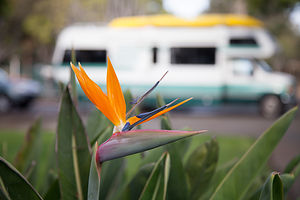 Lazy Daze at Campland on the BayCampland on the Bay is one of the largest campgrounds in California, or for that matter, the entire country. Its popularity stems from its prime location on beautiful Mission Bay and its many water activities: power boating, jet skiing, kayaking, waterskiing, deep-sea fishing, and swimming on its private beach.
Lazy Daze at Campland on the BayCampland on the Bay is one of the largest campgrounds in California, or for that matter, the entire country. Its popularity stems from its prime location on beautiful Mission Bay and its many water activities: power boating, jet skiing, kayaking, waterskiing, deep-sea fishing, and swimming on its private beach.
For those birding enthusiasts, Campland overlooks the Kendall Frost Wildlife Preserve–home to egrets, black-crowned night herons, least terns, and the endangered clapper rail.
Other amenities include: 2 swimming pools and jacuzzis, a world class fitness room, a 124-slip marina, power boat and kayak rentals, bike rentals, the Hungry Wolf BBQ and Ice Cream Parlor, and lots of planned activities on the weekends.
The campground has 558 sites, most with full or partial hookups. There is even one Super Site, complete with private patio, jacuzzi, and grill.
Side Trips from Campland on the Bay
The following is in no way intended to be a complete listing of sights to see in the San Diego area, but just those that we chose to visit during our all too short 2 day stay.
Torrey Pine State Beach
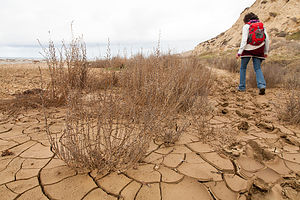 Torrey Pines State Beach ClayTorrey Pines State Beach in La Jolla extends for three miles from Carmel Valley Road in the north to the Glider Port at Torrey Pines Scenic Drive.
Torrey Pines State Beach ClayTorrey Pines State Beach in La Jolla extends for three miles from Carmel Valley Road in the north to the Glider Port at Torrey Pines Scenic Drive.
The north section of the beach is more easily accessible by car and is the choice for families.
Black’s Beach on the southern end is only accessible via two steep trails from the top of the cliff, where the parking lots are. This difficult-to-get-to beach is mostly frequented by two types: surfers looking to enjoy the huge winter swells, and nudists looking to enjoy some privacy. The nudists tend to hang out north of the Glider Port, while the surfers head to the south.
The south trail, which begins just south of the Glider Port, is easier and better maintained than the north trail, in that it has steps and handrails in the steeper segments. The north trail is much steeper and should be avoided if you are subject to vertigo. Both trails are about 1,000 feet long and have an elevation loss of about 320 feet.
It’s also fun to watch the hang gliders and paragliders soar from the Glider Port, atop the cliffs above Black Beach.
La Jolla
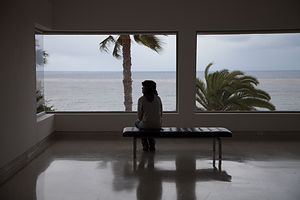 La Jolla Museum of Contemporary Art Ocean ViewThe Native Americans originally called the site La Hoya, meaning “the cave,” referring to the grottoes that dot the shoreline. When the Spaniards arrived, they changed the name to La Jolla (same pronunciation), meaning “the jewel.”
La Jolla Museum of Contemporary Art Ocean ViewThe Native Americans originally called the site La Hoya, meaning “the cave,” referring to the grottoes that dot the shoreline. When the Spaniards arrived, they changed the name to La Jolla (same pronunciation), meaning “the jewel.”
Today, La Jolla certainly is a jewel, and a very expensive one at that. With its stunning coastline and upscale restaurants, shops, and galleries along Girard and Prospect Streets, it is one of the most affluent communities in America.
The Museum of Contemporary Art San Diego is located on a bluff above the waterfront in what was once the residence of philanthropist Ellen Browning Scripps. The museum has over 4,000 works representing every major art movement of the past half century, with a particularly strong emphasis on California artists.
The University of California, San Diego is located in La Jolla, as well as the Scripps Institution of Oceanography, Scripps Research Institute, and Salk Institute.
Cabrillo National Monument
Located at the tip of the Point Luma Peninsula in San Diego, the Cabrillo National Monument marks the site where in 1542 Juan Rodriguez Cabrillo became the first European to set foot on the West Coast of the United States. The Visitor Center has an “Age of Exploration” exhibit and film.
Near the Visitor Center is a small circular plaza with a 14-foot statue of the explorer. The Plaza has an excellent view of San Diego and the harbor.
A short walk from there leads to the Old Point Loma Lighthouse, the highest point in the park. The lighthouse and adjacent Assistant Keepers’ Quarters has exhibits presenting what life was like for the lighthouse keepers in the 1880s.
Just south of the lighthouse is the Whale Overlook, a prime vantage point for viewing migrating Pacific gray whales traveling back and forth between Alaska and Baja California during the months of December through March.
The self-guided, two-mile Bayside Trail begins near the lighthouse and leads visitors through one of the last remaining remnants of a coastal sage scrub forest in the world. This trail offers views of San Diego harbor and the city beyond.
Old Town San Diego State Historic Park
The Old Town State Historic Park, which occupies six square blocks on the site of San Diego’s original pueblo, is dedicated to recreating what life was like in the city during the era of Mexican influence, from 1821 to 1872.
20 historic buildings, a few of which are original, are clustered around the Old Town Plaza. Some of the more noteworthy ones include:
- Robinson-Rose House – built in 1853, this was the original commercial center of Old Town, housing railroad offices, law offices, and the first newspaper press. Today it serves as the Park’s’ Visitor Center and contains a model of what Old Town looked like in 1872
- Casa de Estudillo – the largest and most elaborate of the adobe homes in the park, this one provides a good example of the living conditions of a wealthy family in 1872
- Seeley Stable – this served as a stagecoach stop until 1887, when trains became the preferred mode of transportation. Today it houses an excellent wagon and carriage collection.
- Cosmopolitan Hotel and Restaurant – in 1869 Albert Seeley, a stagecoach entrepreneur purchased this home and turned it into a hotel serving as a way station for travelers making the daylong trip south from Los Angeles.
On Wednesdays and Saturdays, costumed volunteers reenact 19th century life with blacksmithing, cooking, and craft demonstrations.
Mission Beach
The two-mile sandy stretch from the northern entrance of Mission Bay to Pacific Beach is San Diego’s most popular beach. A wide cement boardwalk parallels the beach and is popular with cyclists, joggers, walkers, and rollerbladers.
One of the most prominent features of Mission Beach is the Giant Dipper, a wooden roller coaster built in 1925. This and its twin on the Santa Cruz Beach Boardwalk are the only remaining roller coasters on the West Coast built by the noted coaster builders, Prior and Church.
- ‹ previous
- 9 of 13
- next ›
Campland on the Bay and San Diego Side Trips location map in "high definition"
Javascript is required to view this map.
